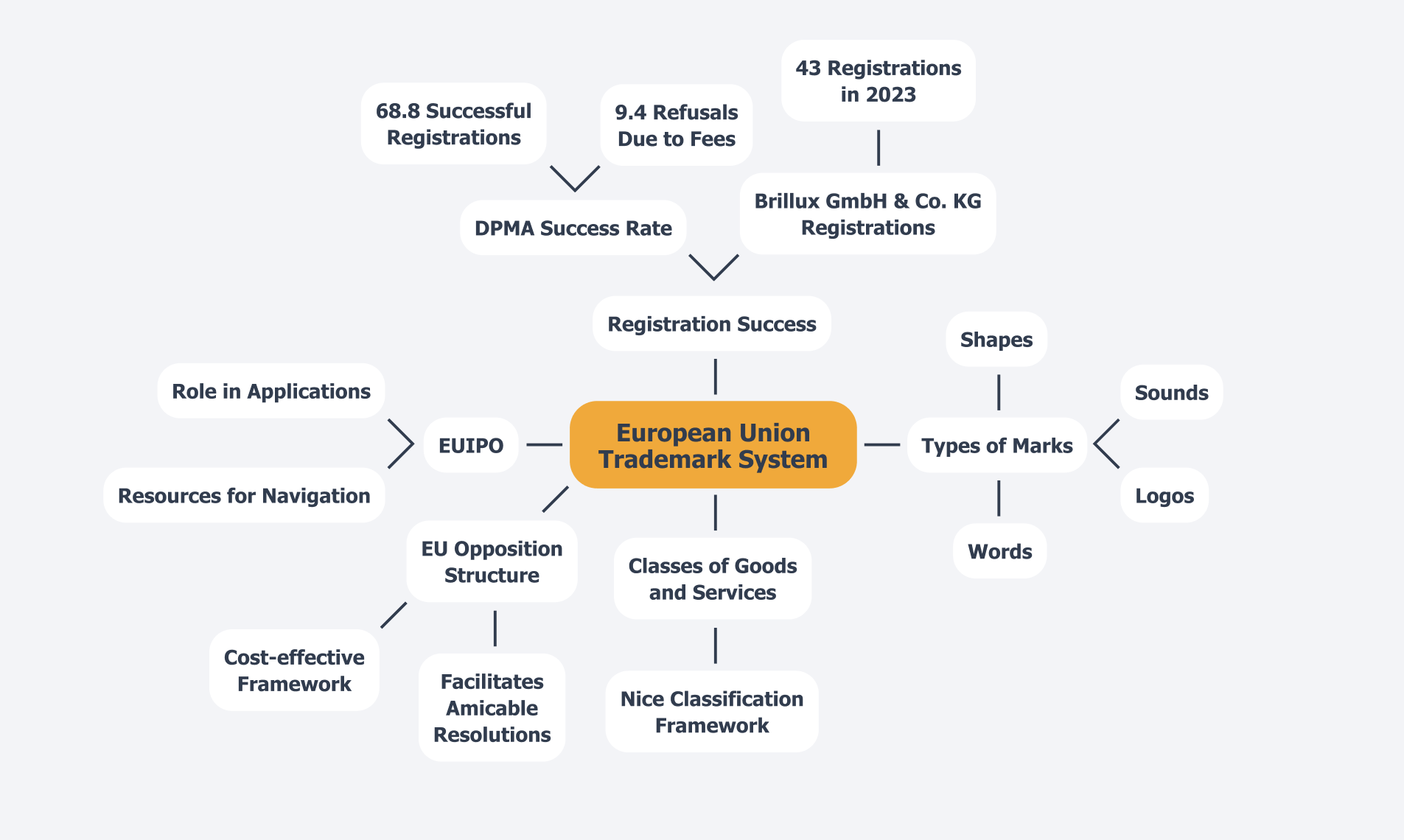Overview
The European Union trade mark search process is crucial for the effective registration and protection of brands across all EU member nations.
By utilizing a single application, businesses can ensure comprehensive coverage. This article outlines key steps in the process:
- Defining the brand
- Utilizing the EUIPO database and TMview for thorough searches
- Monitoring changes in trademark registrations
These steps are essential for navigating potential conflicts and enhancing the prospects of successful trademark registration. How well do you understand these processes? By grasping these pivotal elements, you can significantly improve your trademark registration outcomes.
Introduction
The European Union Trademark (EUTM) system serves as a pivotal resource for businesses seeking to safeguard their intellectual property across a vast and diverse market. By securing a single registration, companies can protect their trademarks in all 27 EU member states, effectively streamlining a process that may otherwise appear overwhelming.
As the landscape of trademark registration evolves, grasping the intricacies of the EUTM system is essential for any organization aiming to preserve its brand identity. This article explores the critical steps and strategies necessary for effective trademark management within the
European Union, from leveraging the EUIPO’s resources to conducting comprehensive trademark searches, while highlighting the challenges and opportunities that lie ahead for businesses in this competitive arena.
Understand the European Union Trademark System
The European Union trade mark search framework offers a highly efficient method for brand registration across all EU member nations, providing a single registration that ensures protection in all 27 countries. This integrated approach significantly simplifies the process for businesses seeking to conduct a European Union trade mark search to protect their intellectual property. Key components of the EUTM system include:
- EUIPO: The European Union Intellectual Property Office plays a crucial role in overseeing trademark applications and registrations. Familiarity with their website and resources is essential for effectively navigating the intellectual property landscape.
- Types of Marks: Trademarks can take various forms, including words, logos, shapes, and sounds. It is imperative to ensure that your mark is distinctive and does not closely resemble existing trademarks to mitigate potential conflicts.
- Classes of Goods and Services: Trademarks are categorized according to the Nice Classification framework. A solid understanding of these classifications is vital for conducting a successful European Union trade mark search and application process.
In 2025, the EUIPO reported a remarkable increase in brand registrations, underscoring the efficiency of the framework and the growing recognition of its benefits. For instance, Brillux GmbH & Co. KG successfully registered 43 brand names in 2023, showcasing the potential for companies to leverage the EUTM framework for robust IP protection. Furthermore, data from the DPMA indicates that 68.8% of finalized procedure processes resulted in successful registrations, highlighting the effectiveness of the registration process, although compliance with fee requirements remains essential. This data reinforces the broader context of brand registrations in the EU, enhancing the credibility of the EUTM framework.
As Robert Reading, Director of Corporate Strategy at Clarivate, remarks, “Analyzing activity here helps us to spot potential risk development, flag areas of growth, and reveals the priorities of major actors.” This insight underscores the importance of understanding the EUTM framework for strategic IP management.
Additionally, the EU opposition structure promotes negotiation by offering a cost-effective framework for lodging oppositions, facilitating
amicable resolutions in brand disputes.
By mastering these essential elements, you will be well-equipped to navigate the brand examination process and fully capitalize on the advantages provided by the European Union Brand system.

Follow the Steps for Conducting a Trademark Search
Conducting a trademark search involves several essential steps to ensure thoroughness and effectiveness:
- Define Your Brand: Clearly outline the brand you wish to explore, including variations and potential spellings. This initial step is crucial as it establishes the groundwork for your inquiry.
- Access the EUIPO Database by utilizing the EUIPO’s eSearch plus tool, which provides access to a comprehensive brand database for conducting a European Union trade mark search. This tool enables you to perform a European Union trade mark search for registered marks by name, number, or image, facilitating a focused inquiry.
- Employ TMview: This complimentary resource provides access to marks filings and registrations throughout EU member nations, enhancing your inquiry through the European Union trade mark search and improving your comprehension of possible disputes.
- Look up by Class: Ensure you look within the appropriate categories of products and services that your brand will encompass. This targeted method assists in recognizing possible disputes and corresponds with the categorization system utilized in brand registrations.
- Analyze Results: Carefully examine the findings, paying close attention to similar brands that could lead to a conflict. Consider the status of these trademarks—whether they are registered, pending, or expired—as this can significantly impact your application strategy.
- Document Findings: Keep a comprehensive account of your search outcomes, highlighting any possible conflicts and the details of comparable marks. As Christophe van Zyl, a Senior Associate, emphasizes, “To safeguard their commercial interests, brand owners need to engage advisors who can not only submit their marks but who also possess negotiation and litigation skills to address oppositions and disputes.” This documentation will be invaluable during your submission process and can assist in strategic decision-making.
In 2023, the fashion sector represented 15% of EUIPO application submissions, highlighting the significance of robust brand protection in
preserving brand integrity. As brand owners navigate this landscape, they should consider the implications of their filing strategies on overall IP management. Moreover, comprehending the typical duration required to perform a European Union trade mark search can assist in establishing practical expectations. The EU opposition system promotes negotiation by offering a cost-effective framework for filing oppositions, facilitating amicable resolutions. Engaging advisors with negotiation and litigation skills can further enhance the protection of commercial interests, especially in this context.

Navigate Challenges in the Trademark Search Process
Navigating the European Union trade mark search process presents significant challenges that demand careful consideration, including the need to identify conflicting trademarks that closely resemble your proposed mark, necessitating a reevaluation of your choice. It is often crucial to alter your brand to minimize potential conflicts, thereby preventing legal disputes.
- Incomplete Searches: Relying solely on the EUIPO database may leave gaps in your search. To uncover all potential conflicts, it is advisable to explore national databases and utilize comprehensive tools like TMview, which aggregates data from multiple jurisdictions, including conducting a European Union trade mark search. Engaging with an intellectual property lawyer when encountering potential conflicts can provide invaluable insights and assist in navigating the complexities of the legal landscape.
- Monitoring Changes: The brand landscape is dynamic, with registrations evolving over time. Consistent observation of new brand registrations is essential to remain updated on any changes that could impact your mark, particularly through a European Union trade mark search, as approximately 30% of brand registrations in the EU are anticipated to face legal obstacles in 2025, underscoring the importance of comprehensive searches. Furthermore, the fashion sector alone represented 15% of EUIPO brand registrations in 2023, highlighting the competitive nature of brand safeguarding in this field. This competitive environment is further illustrated by the fact that 28% of EUIPO application submissions were for Class 35, which includes advertising and business services. By proactively addressing these challenges and employing comprehensive search strategies, businesses can significantly enhance their prospects for successful trademark registration.

Conclusion
The European Union Trademark (EUTM) system serves as an essential mechanism for businesses seeking to safeguard their intellectual property across the varied landscape of the EU. By grasping the complexities of this unified registration process, organizations can secure their trademarks in all 27 member states, thereby streamlining what can often be an overwhelming endeavor. Key elements, such as utilizing the resources of the EUIPO and conducting comprehensive trademark searches, are fundamental steps for effective trademark management.
Navigating the trademark search process demands diligence and strategic foresight. Clearly defining trademarks, leveraging extensive databases like the EUIPO’s eSearch plus and TMview, and meticulously analyzing search results are vital to identifying potential conflicts. Moreover, businesses must stay alert to the ever-changing nature of trademark registrations, as continuous monitoring is imperative to adapt to shifts that could impact their brand identity.
As the competitive landscape evolves, the significance of robust trademark protection cannot be overstated. The challenges posed by conflicting trademarks, incomplete searches, and intricate legalities necessitate a proactive stance on trademark management. Collaborating with knowledgeable advisors can further refine protection strategies, ensuring that brands not only secure their trademarks but also flourish in a competitive marketplace.
Ultimately, mastering the EUTM system and its related processes is critical for any organization dedicated to protecting its brand. By dedicating time and resources to understanding and navigating this system, businesses can effectively shield their intellectual property and position themselves for success in the European market.
Protect Your Brand Across Europe with Ease. Start now with iPNOTE and simplify your trademark management journey!
Frequently Asked Questions
What is the European Union trade mark search framework?
The European Union trade mark search framework offers a highly efficient method for brand registration across all EU member nations, providing a single registration that ensures protection in all 27 countries.
What role does the EUIPO play in the trademark registration process?
The European Union Intellectual Property Office (EUIPO) oversees trademark applications and registrations, making it essential for users to familiarize themselves with their website and resources to navigate the intellectual property landscape effectively.
What types of marks can be registered as trademarks?
Trademarks can take various forms, including words, logos, shapes, and sounds. It is important to ensure that your mark is distinctive and does not closely resemble existing trademarks to avoid potential conflicts.
How are trademarks categorized?
Trademarks are categorized according to the Nice Classification framework, which is vital for conducting a successful European Union trade mark search and application process.
What was reported about brand registrations in 2025?
In 2025, the EUIPO reported a significant increase in brand registrations, highlighting the efficiency of the framework and the growing recognition of its benefits.
Can you provide an example of a successful brand registration?
Brillux GmbH & Co. KG successfully registered 43 brand names in 2023, demonstrating the potential for companies to leverage the EUTM framework for robust intellectual property protection.
What does the data from the DPMA indicate about the registration process?
Data from the DPMA indicates that 68.8% of finalized procedure processes resulted in successful registrations, underscoring the effectiveness of the registration process, although compliance with fee requirements is essential.
How does the EU opposition structure benefit brand disputes?
The EU opposition structure promotes negotiation by offering a cost-effective framework for lodging oppositions, facilitating amicable resolutions in brand disputes.
What should businesses do to navigate the brand examination process effectively?
By mastering the essential elements of the EUTM framework, businesses will be well-equipped to navigate the brand examination process and fully capitalize on the advantages provided by the European Union Brand system.






